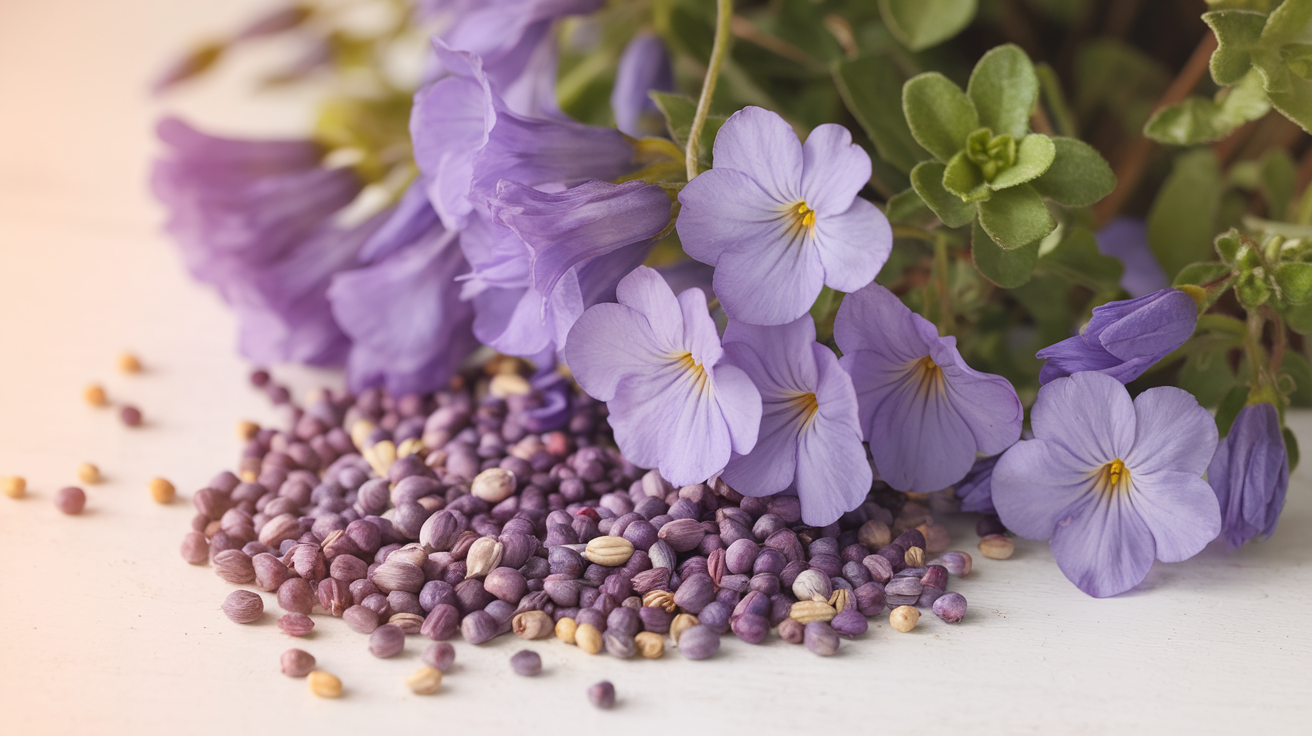Johnny Jump Up seeds are a charming addition to any garden, known for their vibrant colors and easy growth. In this guide, Rhys Garden will share how to plant and care for these delightful flowers, ensuring they bring color and joy to your garden.
What are Johnny Jump Ups?
Johnny Jump Ups, scientifically known as Viola tricolor, are a species of flowering plant in the violet family. These cheerful little flowers are beloved by gardeners for their vibrant colors and ability to self-seed, often “jumping up” in unexpected places around the garden. Here’s what you need to know about these garden favorites:
Origin and History
Johnny Jump Ups have a rich history dating back centuries. They’re native to Europe and western Asia but have naturalized in many parts of the world. These flowers have been cultivated for ornamental purposes since the 16th century and have been a staple in cottage gardens ever since.
Appearance and Characteristics
- Size: Typically grows 4-8 inches tall and wide
- Flowers: Small, about 1 inch in diameter, with three petals
- Colors: Usually purple, yellow, and white, often in combination
- Blooming Period: Spring through fall, with peak blooming in cooler weather
Benefits in the Garden
- Attracts Pollinators: Their nectar-rich flowers are a favorite of bees and butterflies.
- Ground Cover: Can be used as a colorful, low-growing ground cover.
- Edible Flowers: The blooms are edible and can be used to garnish salads or desserts.
- Companion Planting: Works well with other spring-blooming bulbs and perennials.
How to Grow Johnny Jump Ups from Seeds

Growing Johnny Jump Ups from seeds is a rewarding experience that allows you to witness the entire life cycle of these charming flowers. Here’s a step-by-step guide to help you succeed:
Choosing the Right Seeds
When selecting Johnny Jump Up seeds, consider the following:
- Seed Quality: Purchase from reputable sources to ensure viability.
- Variety: Choose from different color combinations or stick with the classic tricolor.
- Organic vs. Conventional: Decide based on your gardening preferences.
Preparing for Planting
Before you sow your Johnny Jump Up seeds, it’s essential to prepare properly:
- Timing: Plan to sow seeds in early spring or fall for best results.
- Soil Preparation: These flowers prefer well-draining, slightly acidic soil (pH 5.5-6.5).
- Location: Choose a spot that receives partial sun to light shade.
Sowing the Seeds
Follow these steps for successful seed sowing:
- Lightly press seeds into the soil surface, as they need light to germinate.
- Space seeds about 4-6 inches apart.
- Keep the soil consistently moist but not waterlogged.
- Germination typically occurs in 10-14 days.
Caring for Seedlings
Once your Johnny Jump Up seedlings emerge, provide the following care:
- Watering: Keep soil evenly moist, especially during dry spells.
- Fertilizing: Apply a balanced, water-soluble fertilizer monthly during the growing season.
- Thinning: If plants are too crowded, thin to 4-6 inches apart.
- Deadheading: Remove spent blooms to encourage continuous flowering.
Common Challenges and Solutions
Even experienced gardeners can face challenges when growing Johnny Jump Ups. Here are some common issues and how to address them:
Pest Control
Johnny Jump Ups can be susceptible to certain pests:
- Aphids: Combat with insecticidal soap or neem oil.
- Slugs and Snails: Use copper tape or diatomaceous earth as barriers.
- Spider Mites: Increase humidity and use miticides if necessary.
Disease Prevention
To keep your plants healthy, watch out for these diseases:
- Powdery Mildew: Improve air circulation and avoid overhead watering.
- Root Rot: Ensure proper drainage and avoid overwatering.
- Leaf Spot: Remove affected leaves and apply fungicide if needed.
Advanced Techniques for Johnny Jump Up Cultivation
For gardeners looking to take their Johnny Jump Up growing to the next level, consider these advanced techniques:
Propagation Methods
While growing from seed is common, you can also propagate Johnny Jump Ups through:
- Division: Divide mature plants in spring or fall.
- Cuttings: Take stem cuttings in late summer and root in a sterile medium.
Hybridization
For the adventurous gardener, try creating your own Johnny Jump Up hybrids:
- Select parent plants with desirable traits.
- Hand-pollinate flowers using a small brush.
- Collect and sow seeds from successful crosses.
Incorporating Johnny Jump Ups in Your Garden Design
These versatile flowers can enhance various garden styles:
Cottage Gardens
- Plant in drifts for a natural, informal look.
- Combine with other spring-blooming perennials like forget-me-nots and daisies.
Rock Gardens
- Use Johnny Jump Ups to fill gaps between rocks.
- Plant in small clusters for pops of color.
Container Gardens
- Create charming window boxes or hanging baskets.
- Mix with trailing plants for added interest.
Harvesting and Using Johnny Jump Ups
Beyond their ornamental value, Johnny Jump Ups have practical uses:
Edible Flowers
- Harvest flowers in the morning when fully open.
- Rinse gently and use as a garnish for salads, desserts, or cocktails.
Pressed Flowers
- Press Johnny Jump Up flowers for use in crafts or botanical art.
- Use a flower press or place between heavy books for best results.
Seasonal Care for Johnny Jump Ups
To keep your Johnny Jump Ups thriving year-round, follow these seasonal care tips:
Spring
- Sow seeds or transplant seedlings as soil warms.
- Apply a slow-release fertilizer to support new growth.
Summer
- Provide afternoon shade in hot climates.
- Mulch to retain moisture and keep roots cool.
Fall
- Sow seeds for early spring blooms.
- Cut back spent foliage to tidy up plants.
Winter
- In mild climates, Johnny Jump Ups may continue to bloom.
- In colder regions, protect with a layer of mulch.
Frequently Asked Questions About Johnny Jump Up Seeds
To address common queries gardeners have about Johnny Jump Ups, here are some frequently asked questions:
Q: Are Johnny Jump Ups annual or perennial?
A: Johnny Jump Ups are technically short-lived perennials but are often grown as annuals. In mild climates, they can persist for several years.
Q: How long do Johnny Jump Ups bloom?
A: With proper care, Johnny Jump Ups can bloom from spring through fall, with peak flowering in cooler weather.
Q: Can Johnny Jump Ups grow in full sun?
A: While they can tolerate full sun in cooler climates, Johnny Jump Ups generally prefer partial shade, especially in warmer regions.
Q: Are Johnny Jump Ups deer resistant?
A: Yes, Johnny Jump Ups are generally considered deer resistant, making them a good choice for gardens in deer-prone areas.
Q: How often should I water Johnny Jump Ups?
A: Water Johnny Jump Ups when the top inch of soil feels dry. They prefer consistent moisture but not waterlogged conditions.
Companion Plants for Johnny Jump Ups
Enhance your garden’s beauty and health by pairing Johnny Jump Ups with complementary plants:
- Spring Bulbs: Plant with daffodils or tulips for a layered spring display.
- Herbs: Combine with low-growing herbs like thyme or oregano.
- Shade-Loving Plants: Partner with hostas or ferns in shadier areas.
The Cultural Significance of Johnny Jump Ups
These charming flowers have captured the hearts of gardeners and artists alike:
- Folklore: In some cultures, Johnny Jump Ups are associated with love and remembrance.
- Art: Featured in many paintings and botanical illustrations throughout history.
- Literature: Mentioned in poetry and prose, often symbolizing modesty and simplicity.
Environmental Benefits of Growing Johnny Jump Ups
By cultivating these flowers, you’re contributing to a healthier ecosystem:
- Pollinator Support: Provides food for bees, butterflies, and other beneficial insects.
- Soil Health: Their root systems help prevent soil erosion.
- Biodiversity: Adds to the variety of plant life in your garden, supporting overall ecosystem health.
Johnny Jump Ups in Container Gardening
For those with limited space, Johnny Jump Ups are excellent container plants:
- Pot Selection: Choose containers with good drainage, at least 6 inches deep.
- Soil Mix: Use a well-draining potting mix enriched with compost.
- Watering: Container-grown plants may need more frequent watering.
Preserving Johnny Jump Up Seeds
To maintain your own seed stock for future plantings:
- Allow some flowers to go to seed naturally.
- Collect seed pods when they turn brown and begin to split.
- Store seeds in a cool, dry place in paper envelopes.
Conclusion
Planting Johnny Jump Up seeds is a simple way to add a splash of color to your garden. With minimal care, these cheerful flowers will thrive, brightening your outdoor space with their lively blooms.

Related Posts
Are Wild Flowers Perennial? Unveiling Nature’s Blooming Secrets
The Art of Transplanting Japanese Maple
Designer Garden Gate With Pergola: Elevate Your Garden Entrance